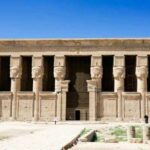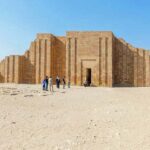As one of the most important achievements of the last century in Egypt, Aswan High Dam, for many years was responsible for around 50 % of the electricity production in Egypt, providing electricity to most of Egypt’ villages for the first time. By regulating the flow of the river, the dam also increased the cultivatable land in Egypt by around 30% and allowed development in new areas that were previously inundated annually when the river flooded.
Only a few decades after the completion of the first dam, its regulatory effect was so unsatisfactory that plans for extension and improvement were urgently needed. President Nasser, who gained power in 1952 energetically supported a project for which Britain, the USA and the World Bank promised him financial help. When the western powers withdrew their financial backing in 1956 due to Nasser’s policy of neutrality, Nasser sought a new partner. He found it in the Soviet Union, which aided Egypt with credit and the help of about 2,000 engineers and technical workers.
This article contains information about visiting Aswan High Dam including:
The location and specifications of Aswan Dam
Aswan Dam located near Aswan, the world famous High Dam was an engineering miracle when it was built in the 1960. It contains 18 times the material used in the Great Pyramid of Cheops. The Dam is 11,811 feet long, 3215 feet thick at the base and 364 feet tall, Today it provides irrigation and electricity for the whole of Egypt and together with the old Aswan Dam built by the British between 1898 and 1902, 6km down river, gorgeous views for visitors, From the top of the two Mile long High Dam you can look across Lake Nassar, the huge reservoir created when it was built to Kalabsha temple in the south and the huge power station to the north.
The Aswan High Dam was wonderful project, In fact it was one of the most important achievements of the last century in Egypt, for many years symbolizing the New Era after 1952.
The Aswan High Dam, about 7km/4mi above the old dam, is mainly a gigantic pile of gravel, rubble and sand around a clay core, covered by a concrete mantle. More than 40 million cubic metres of material were used.
It is just 4km/2.4mi long and 111m/366ft high. The dam is 980m/1,070yd wide at its base; at the top, it narrows to 40m/130ft. There is a blossom-shaped monument at the western end.
The hydroelectric power plant at the high dam has 12 Francis turbines that produce an average of 1.1 gigawatts of electricity; the power is transmitted all the way to Cairo. Thle power is essential for the industrial development of the Nile valley. The high dam blocks the Nile to form Lake Nasser, which has a surface area of 6,000 sq km/2,317 sq mi. One third of the 500km/ 300mi long and 35km/21mi wide lake lies on Sudanese state territory. Lake Nasser is the third largest manmade lake on the planet and has a volume of 165 billion cubic metres. Most of the water is used for irrigation purposes. But a large amount also evaporates.
A pumping station is currently being built at Lake Nasser, which is supposed to help irrigate parts of the south-western Egyptian desert. A new settlement and economic area for about 3 million people is supposed to be constructed there.
When was the high dam built?
When construction began on the High Dam in 1960, it was the most heralded part of President Gamal Abdel Nasser’s effort to develop Egypt for all Egyptians. While the dam is certainly not the largest in the world, it is an impressive engineering feat nonetheless, over 360 feet tall and 12,500 feet across.
The dam was completed in 1971 and the huge reservoir behind it, named for President Nasser, finished filling in 1979.
How to Visit Aswan Dam?
The dam is only about a 15-minute drive south of Aswan so a visit is easy even if your time in the city is limited. It is an impressive sight and views south over Lake Nasser and north toward the old Aswan Dam are spectacular. Don’t be deterred by the tight security. The dam is heavily guarded since it would wash most of Egypt into the Mediterranean if it burst.
How much does it cost to visit the Aswan High Dam?
Tickets, which cost 100 Egyptian pounds (approximately $6) can be purchased at the entrance’s gate.
The benefits and effects of Aswan High Dam
In May 1964, the canal on the eastern Nile shore was opened. The high dam was inaugurated in January 1971. Nearly 30,000 Egyptian workers had participa-ted in the creation of this gigantic structure. The rising floods necessitated the resettlement of about 140,000 Nubians and Sudanese, as well as one of the most unusual international rescue programmes for the preservation of monuments. Numerous monuments were removed from their old location and rebuilt in new places.
The benefits of the high dam
The Aswan High Dam yields enormous benefits to the economy of Egypt, The first time in history, the annual Nile flood can be controlled by man, The dam detain the floodwaters, releasing them when needed to maximize their utility on irrigated land, to water hundreds of thousands of new acres, to develop navigation in Aswan, and to generate enormous amounts of electric power.
When the dam first reached peak output it produced around half of Egypt’s entire electricity production (about 15% by 1998) and allowed for the connection of most Egyptian villages to electricity for the first time.
The dam has also provided much needed water for irrigation, as well as producing electricity from the hydroelectric output of the river, The dam helped Egypt to reach its highest ever level of electric production, granting many small villages the luxury of using electricity for the first time. Prepare yourself for a particularly sightseeing experience in Aswan with Bastet Travel
The Egyptian countryside benefited from the Aswan High Dam through improved irrigation as well as electrification. The dams also protected Egypt from the droughts in 1972–73 and 1983–87 that devastated East and West Africa. The High Dam allowed Egypt to reclaim about 2.0 million feddan (840,000 hectares) in the Nile Delta and along the Nile Valley, increasing the country’s irrigated area by a third. The increase was brought about both by irrigating what used to be desert and by bringing under cultivation of 385,000 ha that were previously used as flood retention basins. About half a million families were settled on these new lands. In particular the area under rice and sugar cane cultivation increased. In addition, about 1 million feddan (420,000 hectares), mostly in Upper Egypt, were converted from flood irrigation with only one crop per year to perennial irrigation allowing two or more crops per year. On other previously irrigated land, yields increased because water could be made available at critical low-flow periods. For example, wheat yields in Egypt tripled between 1952 and 1991 and better availability of water contributed to this increase. Most of the 32 km3 of freshwater, or almost 40 percent of the average flow of the Nile that were previously lost to the sea every year could be put to beneficial use. While about 10 km3 of the water saved is lost due to evaporation in Lake Nasser, the amount of water available for irrigation still increased by 22 km3. Other estimates put evaporation from Lake Nasser at between 10 and 16 cubic km per year.
The dam powers twelve generators each rated at 175 megawatts (235,000 hp), with a total of 2.1 gigawatts (2,800,000 hp). Power generation began in 1967. When the High Dam first reached peak output it produced around half of Egypt’s production of electric power (about 15 percent by 1998), and it gave most Egyptian villages the use of electricity for the first time. The High Dam has also improved the efficiency and the extension of the Old Aswan Hydropower stations by regulating upstream flows.
The Effects of Aswan Dam
The project has always carried controversy with it. The construction displaced over 100,000 Nubian, whose civilization had called the banks of the Nile in southern Egypt and northern Sudan home for millennia, and the rising waters threatened a number of important ancient monuments and archeological sites. Despite this, the dam provides significant benefits to the people of Egypt.
The High Dam has resulted in protection from floods and droughts, an increase in agricultural production and employment, electricity production, and improved navigation that also benefits tourism. Conversely, the dam flooded a large area, causing the relocation of over 100,000 people. Many archaeological sites were submerged while others were relocated. The dam is blamed for coastline erosion, soil salinity, and health problems.
The assessment of the costs and benefits of the dam remains controversial decades after its completion. According to one estimate, the annual economic benefit of the High Dam immediately after its completion was E£255 million, $587 million using the exchange rate in 1970 of $2.30 per E£1): £140 million from agricultural production, £100 million from hydroelectric generation, £10 million from flood protection, and £5 million from improved navigation. At the time of its construction, total cost, including unspecified “subsidiary projects” and the extension of electric power lines, amounted to £450 million. Not taking into account the negative environmental and social effects of the dam, its costs are thus estimated to have been recovered within only two years. One observer notes: “The impacts of the Aswan High Dam (…) have been overwhelmingly positive. Although the Dam has contributed to some environmental problems, these have proved to be significantly less severe than was generally expected, or currently believed by many people.”Another observer disagreed and he recommended that the dam should be torn down. Tearing it down would cost only a fraction of the funds required for “continually combating the dam’s consequential damage” and 500,000 hectares of fertile land could be reclaimed from the layers of mud on the bed of the drained reservoir.
Periodic floods and droughts have affected Egypt since ancient times. The dam mitigated the effects of floods, such as those in 1964, 1973, and 1988. Navigation along the river has been improved, both upstream and downstream of the dam. Sailing along the Nile is a favorite tourism activity, which is mainly done during the winter when the natural flow of the Nile would have been too low to allow navigation of cruise ships.[clarification needed] A new fishing industry has been created around Lake Nasser, though it is struggling due to its distance from any significant markets. The annual production was about 35 000 tons in the mid-1990s. Factories for the fishing industry and packaging have been set up near the Lake








